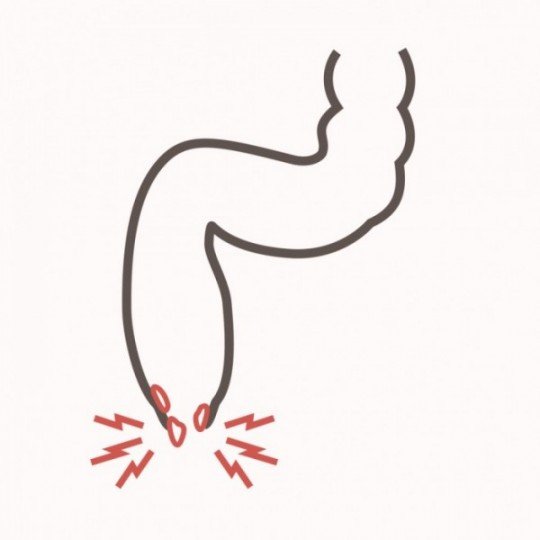
Do You Know the Difference Between Rectal Prolapse and Hemorrhoids?
We continue Pelvic Organ Prolapse Awareness Month by talking about Rectal prolapse and hemorrhoids, two conditions that are commonly mistaken for one another.
Rectal prolapse and hemorrhoids can both cause irritation, discomfort, and pain in the anal region. However the causes and treatment can be different for both conditions.
Hemorrhoids
Internal hemorrhoids are swollen veins inside the rectum. Sometimes these swollen veins begin to descend and come out through the anal sphincter.
External hemorrhoids: are swollen veins that can be seen and often felt under the skin outside around the anal sphincter. Usually they look like a small bulge and are the same color as the skin.
Hemorrhoid Symptoms
The most common signs of hemorrhoids are:
- Bright red blood on toilet paper
- Drops of blood in the stool
- Pain at the anus
- Burning, pressure, or intense itchiness at the anus
About 75% of adults in America will have hemorrhoids at some point in their lives.
Causes of hemorrhoids
- Chronic constipation or diarrhea
- History of straining during bowel movements
- Poor diet, especially one low in fiber
- Dehydration
- Sedentary lifestyle
Rectal Prolapse
Rectal prolapse occurs when the points of attachment of the rectum (the last part of the colon, before the anal sphincter) become overstretched or detach from inside the body, and begins to descend out of the anus.
Rectal Prolapse Symptoms
When comparing rectal prolapse and hemorrhoids, rectal prolapse can cause symptoms similar to hemorrhoids, including:
- Bright red blood on toilet paper
- Drops of blood in the stool
- Pain at the anus
- Burning, pressure, or intense itchiness at the anus
Other symptoms that are specific to rectal prolapse and not usually present in hemorrhoid cases include:
- Incontinence or leakage of stool.
- A feeling of fullness in the bowel
- Tissue coming out of the anus looks like it is “telescoping” and has the appearance of concentric circles.
Causes of Rectal Prolapse
- Chronic constipation or diarrhea
- History of straining during bowel movements
- Pelvic floor muscle weakness
- Deterioration of the muscles and ligaments of the rectum due to age.
- Weakening of the anal sphincter: This is the specific muscle that controls the release of stool from the rectum.
- Prior injury to the anal or pelvic areas including pregnancy, labor, and delivery.
- Nerve damage as a result of pregnancy, vaginal childbirth, anal sphincter paralysis, spinal injury, back injury/back surgery, and/or other surgeries of the pelvic area.
- Other diseases, conditions, and infections: Rectal prolapse can be a consequence of diabetes, cystic fibrosis, chronic obstructive pulmonary disease, hysterectomy, and infections in the intestines caused by parasites – such as pinworms and whipworms – and diseases resulting from poor nutrition or from difficulty digesting foods.
Treatment for rectal prolapse and hemorrhoids with pelvic floor physical therapy
Surgery is the best treatment in severe cases of rectal prolapse. In less severe cases of rectal prolapse and hemorrhoids, a trained and licensed pelvic floor physical therapist, like us at Femina Physical Therapy, can help treat the toileting habits and pelvic floor dysfunction that is associated with both conditions.
A licensed pelvic floor therapist can conduct a thorough evaluation of the pelvic floor and help you come up with strategies to have a bowel movement without straining.
Examination may include an internal exam via the vagina or rectum, observing the movement and coordination of the pelvic floor muscles, as well as palpation of the structures of the belly and pelvic area.
The ultimate goal of our treatment plans at Femina Physical Therapy is to help you fully relax the pelvic floor, and to be able to have a complete bowel movement without the strain or pain brought on by rectal prolapse and hemorrhoids. This might include manual therapy to treat tight and guarding pelvic floor muscles that may be preventing healthy bowel movements.
Other treatments will help with neuromuscular retraining, helping your brain and muscles coordinate correctly so that you are actually relaxing your muscles when you think you are relaxing them. Your therapist will also work with you to create healthy bowel habits, problem solve positioning on the toilet, the time you are spending on the toilet, and other habits that can help create regularity.
There are plenty of options for treating both rectal prolapse and hemorrhoids. For those with rectal prolapse, a pelvic floor physical therapist will also be able to help strengthen the pelvic floor muscles that are too weak to support your organs when the time is right.
References:
American College of Gastroenterology.
American Society of Colon & Rectal Surgeons. Mahmoud NN. Rectal Prolapse. https://www.fascrs.org/patients/disease-condition/rectal-prolapse-expanded-version
Cleveland Clinic. Rectal Prolapse. https://my.clevelandclinic.org/health/diseases/14615-rectal-prolapse
Mayo Clinic. Hemorrhoids. https://www.mayoclinic.org/diseases-conditions/hemorrhoids/symptoms-causes/syc-20360268
**This information is for educational purposes only and is not intended to replace the advice of your doctor.
